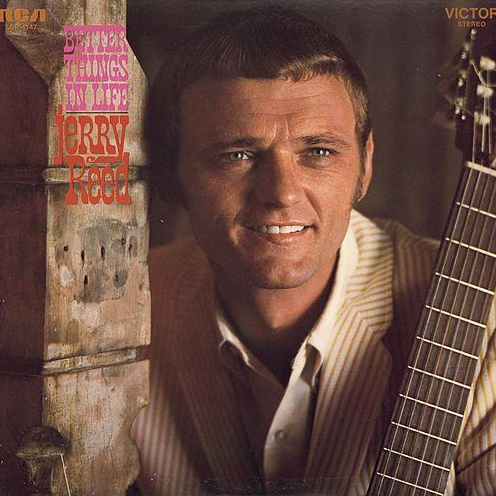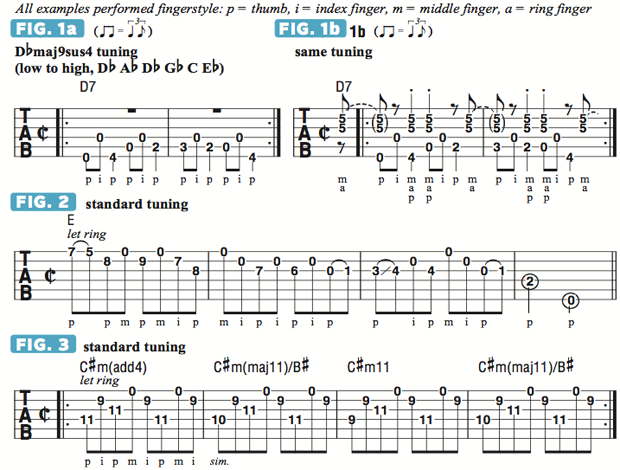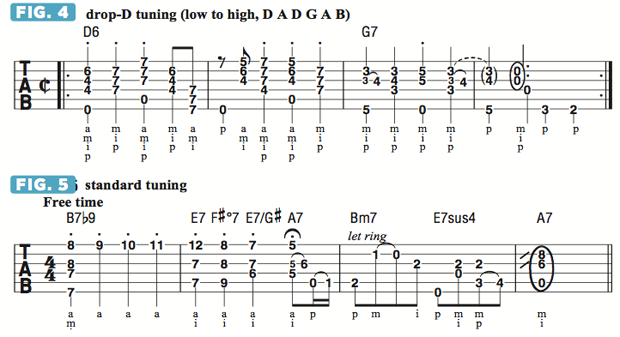The Complex and Groovy Fingerpicking of Guitarist/Actor Jerry Reed

Jerry Reed (1937–2008), known by many as Burt Reynolds’ truck-driving partner in crime in the 1977 film Smokey and the Bandit, was also a highly accomplished and influential guitar picker—influencing the likes of Eric Johnson, Brent Mason, John Jorgensen, Tommy Emmanuel, Steve Morse and countless others—revered for his mind-boggling “guitar dueling” records with Chet Atkins, as well as a thriving songwriting career that spawned tunes that even Elvis Presley covered (“Guitar Man”).
How Reed managed to maintain his guitar chops while being a major film star—in later years, Jerry also appeared in Adam Sandler’s The Waterboy and with Robin Williams in The Survivors—is anyone’s guess.
Let’s look at some of the technical and stylistic elements that made Reed a great player.
He used a thumbpick, so if you have one, use it in every instance a thumbstroke (p) is indicated in the following examples.
In 1967, after having had songwriter success with “Crazy Legs” (as recorded by Gene Vincent and His Blue Caps) and “That’s All You Gotta Do” (as recorded by Brenda Lee), Reed struck gold with “Guitar Man” (The Unbelievable Guitar and Voice of Jerry Reed), a groovy acoustic blues played in the highly unusual Dbmaj9sus4 tuning (low to high, Db Ab Db Gb C Db). (Think “drop-D, down a half step,” with the B string then tuned up a whole step.)
The song is propelled by a bass line similar to that in FIGURE 1a. Fret the bass notes with your index and middle fingers, reserving the ring finger and pinkie for the double-stop in FIGURE 1b; pick as indicated for the complete verse riff.
Atkins, long enamored with Reed’s playing (Chet produced JR’s “If I Don’t Live Up to It” single in 1965), joined forces with Reed in 1970 on the devastating guitar duo record, Me & Jerry, earning the two a Grammy for Best Instrumental Performance.
All the latest guitar news, interviews, lessons, reviews, deals and more, direct to your inbox!
They paired up again in 1972 with Chet & Me (Jerry in the left speaker, Chet in the right), which opens with the blistering “Jerry’s Breakdown,” the signature line from which informs FIGURE 2. Fingerpick as indicated and let the notes ring together as much as possible. FIGURE 3 is similar to the tune’s middle section, where Reed fingerpicks arpeggios at lightning speed. Perfect the pattern in bar 1 first; in later bars, the fourth string’s notes descend in half steps.
In 1975, Reed issued Mind Your Love, an album ending with the drop-D-tuned solo guitar piece, “Struttin’,” its fret-hand insanity hinted at in FIGURE 4. Barre your index finger across the top four strings, then fret the opening chord, add an extra note, A (first string, fifth fret), with the middle finger “pre-fretting” a chord fragment that opens bar 2, and don’t move the fingers otherwise. You can then barre all the seventh-fret partial chords in measures 1 and 2 with the pinkie.
FIGURE 5 is inspired by the “free-time” ending of Reed’s signature solo instrumental “The Claw,” one of the most covered “super chops” solo guitar pieces by students interested in Reed/Atkins/Travis–style fingerpicking.


A singer-songwriter/multi-instrumentalist/film composer, Musician's Institute instructor, and author of 50+ transcription/instructional books, Dale Turner is also Guitar World's "Hole Notes"/"Acoustic Nation" columnist, and the former West Coast Editor of Guitar One magazine. Some of Dale’s old, weird, rare, and/or exotic instruments are featured in his score for WEEDS, the first animated short completed within the Filmmakers Co-op at Disney Feature Animation. His most recent CD, Mannerisms Magnified, was praised by Guitar Player magazine for its "Smart pop tunes that are crammed with interesting guitar parts and tones ... Like what the Beach Boys might do if they were on an acid trip that was on the verge of getting out of control. Yeah!"

